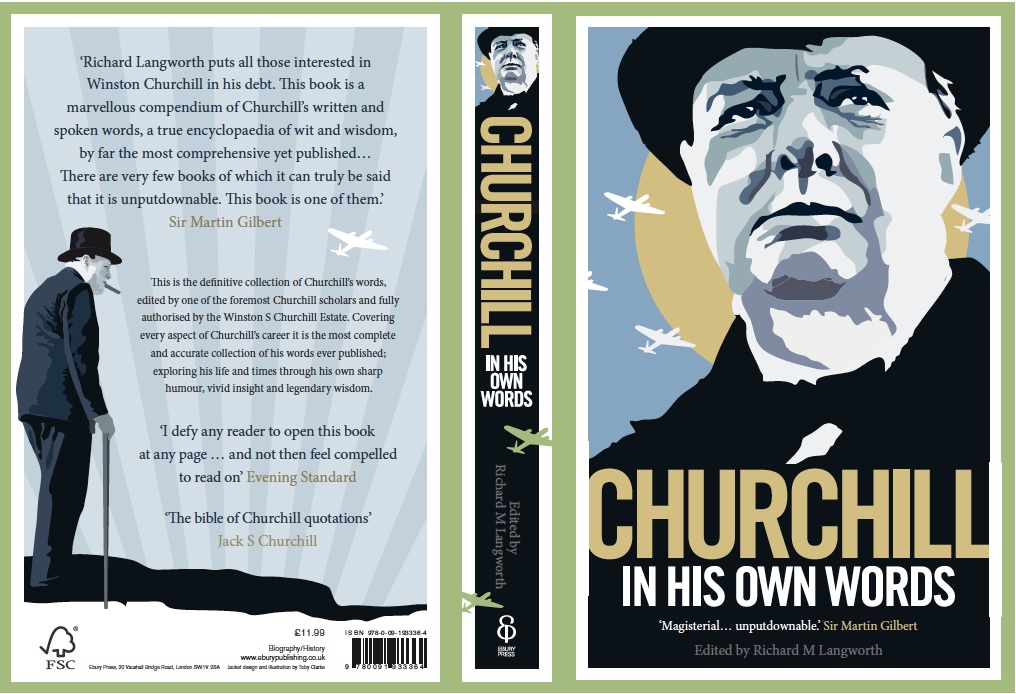
Books
Books produced by Richard M. Langworth. (Out-of-print titles can often be found by searching on Amazon or Bookfinder.) The count through 2018: seventy-two books, sixty-one automotive and eleven Churchill, of which five are books of Churchill quotations.
“Another damned thick book! Always scribble, scribble, scribble! Eh, Mr. Gibbon?” (Duke of Gloucester to Edward Gibbon, 1781)
“Dear Winston, Thank-you for your latest book. I have put it on the shelf with all the others.” (Duke of Windsor to WSC, 1938 (Clementine Churchill thought this hilarious, and dined out on it many times.)
Latest Books
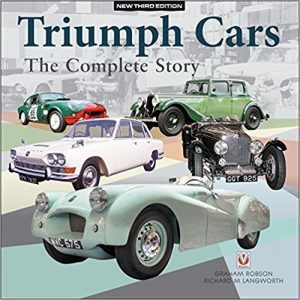 Triumph Cars: The Complete Story (with Graham Robson). New revised and expanded edition. Coming in September, pre-publication orders accepted now. Graham and I have revised and updated the story, with new information since the previous edition in the 1980s, and adding dozens of fine new color photos. This is the most elaborate and luxurious edition ever. It relates Triumph’s story from the spindly roadsters of 1923 through the great racing and rally cars of the 1930s-70s, to the last TR8, to the 1984 Triumph Acclaim.
Triumph Cars: The Complete Story (with Graham Robson). New revised and expanded edition. Coming in September, pre-publication orders accepted now. Graham and I have revised and updated the story, with new information since the previous edition in the 1980s, and adding dozens of fine new color photos. This is the most elaborate and luxurious edition ever. It relates Triumph’s story from the spindly roadsters of 1923 through the great racing and rally cars of the 1930s-70s, to the last TR8, to the 1984 Triumph Acclaim.
Amazon: “Not merely a turbulent trawl through the historical record, it includes first-person commentary by important Triumph designers, engineers and drivers. Cars as famous as the Glorias and Dolomites of the 1930s, the Renowns, Spitfires and TRs of the postwar years, produced headline-grabbing exploits in racing and rallying—a story which no fictional writer could have created.
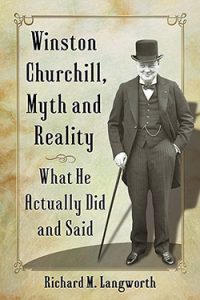 Winston Churchill, Myth and Reality: What He Actually Did and Said. The outrageous attacks on Churchill in the wake of the movie Darkest Hour makes this book indispensable. This ground-breaking book refutes attacks on Churchill’s actions and character. Among them: that he opposed votes for women, was an enemy of Irish independence, cost lives on Gallipoli, promoted poison gas, hated Gandhi and the Jews, admired Hitler, praised Mussolini, knew about Pearl Harbor beforehand, allowed Coventry to be bombed to protect secret intelligence, firebombed Dresden, refused to bomb Auschwitz, and wanted to nuke the Russians. (For a start.)
Winston Churchill, Myth and Reality: What He Actually Did and Said. The outrageous attacks on Churchill in the wake of the movie Darkest Hour makes this book indispensable. This ground-breaking book refutes attacks on Churchill’s actions and character. Among them: that he opposed votes for women, was an enemy of Irish independence, cost lives on Gallipoli, promoted poison gas, hated Gandhi and the Jews, admired Hitler, praised Mussolini, knew about Pearl Harbor beforehand, allowed Coventry to be bombed to protect secret intelligence, firebombed Dresden, refused to bomb Auschwitz, and wanted to nuke the Russians. (For a start.)
This book defends Churchill’s good name over issues still on our minds today. Why is Churchill so widely quoted and admired? Because he stood for something. His devotion to freedom, his magnanimity toward former foes, solved many intractable problems. Churchill was not infallible. But his faults were eclipsed by his virtues, and his record stands undiminished. Also available for Kindle.
2015
Churchill and the Avoidable War: Could World War II have been Prevented? World War II was the defining event of our age—the climactic clash between democracy and tyranny, liberty and the all-dominant state. It killed more people, military and civilian, than any war in history. It led to revolutions, religious and sectarian strife, the demise of empires, a protracted Cold War. Churchill maintained that it all could have been prevented. Was he right? Yes, possbibly, at one juncture in particular. But it could not have been done without great difficulty.
This book examines Churchill’s theory—not in retrospect but at the time—his prescriptions, his actions, and the degree to which he pursued them. I conclude that Churchill was both right and wrong: right that Hitler could have been stopped; wrong that he did all he could to stop him. The result is a kind of “re-revisionism”: a corrective to traditional arguments, both of Churchill’s critics and defenders. It is based on what really happened—evidence that has been “hiding in public” for many years.
2012
 The Churchill Companion: A Concise Guide to the Life & Times of Winston Churchill. Second Edition, 2012. The ultimate Churchill facts book is now in its Second Revised Edition, with a cover by Richard Deane Taylor and high-gloss-laminated to protect from frequent use. The spiral-bound Companion lays flat at any page and is very handy for researchers.
The Churchill Companion: A Concise Guide to the Life & Times of Winston Churchill. Second Edition, 2012. The ultimate Churchill facts book is now in its Second Revised Edition, with a cover by Richard Deane Taylor and high-gloss-laminated to protect from frequent use. The spiral-bound Companion lays flat at any page and is very handy for researchers.
A score of expert authors and historians put every useful fact about Churchill at your fingertips, from the names of his race horses to the dates of his great wartime broadcasts—with numerous internet links to words, music and texts. The Timeline, which goes from the year Churchill’s parents met to the death of Clementine Churchill, marks every significant date in Churchill’s life. Chapters on travel pinpoint his movements in Canada and the U.S., in World War II, and at all his sea voyages.
Contents: 1873-1977 Timeline, Books by Churchill, Books About Churchill, Wartime Broadcasts, Pound-Dollar Values 1874- 2014, Film and Television, election Results 1899-1959, Family Tree, Best Finest Hour Articles, Funeral Services, Glossary of Parliamentary and Political Terms, Governments, Sovereigns, Prime Ministers, Nobility, Churchill’s Orders Decorations and Medals, Favorite Hotels, Military Commissions and Units, Leading Churchill Myths, Offices Held by WSC, British Political Parties, Churchill’s Residences, Private and Parliamentary Secretaries, Summit Conferences in World War II, Thoroughbred Horses, Travel by Sea, Travel to North America, Travel in World War II, and the Chartwell Visitor’s Book. Corrections and additions, entered with the kind assistance of Ronald Cohen, include new entries for Churchill’s first speech ever (1895), his first political speech (1897), and his three speeches to the U.S. Congress. Here is a fountain of information you can’t find in any other single source, indispensable for knowing or researching Churchill’s life and times.
Churchill Quote Books 2008-12
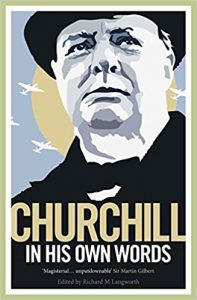 Churchill in His Own Words: New Revised Edition. This is the latest edition of Churchill by Himself (see below), with numerous corrections and resolutions of conflicting quotes and sources. A boon to researchers, it is also available as a Rosetta electronic edition. The jumbo softbound print edition is available from Amazon UK, and from private sellers on Amazon USA. If you want a hard copy, this is the one to buy. It contains the latest corrections (not to say I have a few more for the next edition—if there is one. More importantly, both the e-book and this edition contain a new “Phrase Index” to over 400 commonly sought Churchill quips and quotes, making it much easier to find the one you’re looking for.
Churchill in His Own Words: New Revised Edition. This is the latest edition of Churchill by Himself (see below), with numerous corrections and resolutions of conflicting quotes and sources. A boon to researchers, it is also available as a Rosetta electronic edition. The jumbo softbound print edition is available from Amazon UK, and from private sellers on Amazon USA. If you want a hard copy, this is the one to buy. It contains the latest corrections (not to say I have a few more for the next edition—if there is one. More importantly, both the e-book and this edition contain a new “Phrase Index” to over 400 commonly sought Churchill quips and quotes, making it much easier to find the one you’re looking for.
* * *
All Will Be Well: Good Advice from Winston Churchill. London: Ebury Press/Random House, Spring 2011. A feel-good book encapsulating the Great Man’s more upbeat messages (which we can certainly use at the present time), the third spin-off from Churchill By Himself.
In troubled times who better to turn to for advice and reassurance than the man who led Britain through her most difficult days—and believe me, things were worse in 1940. Collected here are the upbeat words of the the Greatest Briton. By turns witty, dry, rousing and wise, it’s an antidote to the stresses and strains of our times.Typifying the quotations in its 160 pages: “Strength is granted to us all when we are needed to serve great causes….Sometimes when Fortune scowls most spitefully, she is preparing her most dazzling gifts….We shall not be judged by the criticisms of our opponents but by the consequences of our acts.” As Churchill often reminded family and friends in challenging times: “KBO”—Keep Buggering On.
* * *
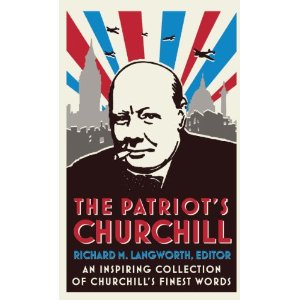 The Patriot’s Churchill. London: Ebury Press/Random House. A handbook of Churchill’s inspiring words on Britain, America and their traditions of liberty, quotations gleaned from books, articles, speeches, private papers and conversations, compiled with the assistance of scholars, family members and those who knew him. In an age of widespread cynicism toward politics, The Patriot’s Churchill shows that Churchill knew things can be different—emphasizing his precepts of collegiality and friendship toward political opponents, magnanimity in victories, and wry reflections after defeats. Chapters include The Flag; Visions of Britain, America and the Commonwealth; Equality; Freedom of Speech and Religion; Freedom from Want and Fear; Political Conduct; Great Britons and Americans; Independence; the Individual; Peace and War; Rule of Law; Service to the Nation.
The Patriot’s Churchill. London: Ebury Press/Random House. A handbook of Churchill’s inspiring words on Britain, America and their traditions of liberty, quotations gleaned from books, articles, speeches, private papers and conversations, compiled with the assistance of scholars, family members and those who knew him. In an age of widespread cynicism toward politics, The Patriot’s Churchill shows that Churchill knew things can be different—emphasizing his precepts of collegiality and friendship toward political opponents, magnanimity in victories, and wry reflections after defeats. Chapters include The Flag; Visions of Britain, America and the Commonwealth; Equality; Freedom of Speech and Religion; Freedom from Want and Fear; Political Conduct; Great Britons and Americans; Independence; the Individual; Peace and War; Rule of Law; Service to the Nation.
* * *
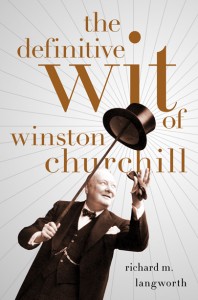 The Definitive Wit of Winston Churchill. London: Ebury Press/Random House; New York: Public Affairs, Autumn 2009. Distilled from Churchill by Himself and about one-seventh of its length, this book captures Churchill’s wit and wisdom on a broad variety of topics. Over 100 new quotations are added which are not in Churchill by Himself. Forthcoming in Autumn 2009 at a price you can afford, hopefully destined for the “popular titles” counters, where we hope it will stay in print forever. The jacket for the Public Affairs edition is what Churchill would call a “Wow.”
The Definitive Wit of Winston Churchill. London: Ebury Press/Random House; New York: Public Affairs, Autumn 2009. Distilled from Churchill by Himself and about one-seventh of its length, this book captures Churchill’s wit and wisdom on a broad variety of topics. Over 100 new quotations are added which are not in Churchill by Himself. Forthcoming in Autumn 2009 at a price you can afford, hopefully destined for the “popular titles” counters, where we hope it will stay in print forever. The jacket for the Public Affairs edition is what Churchill would call a “Wow.”
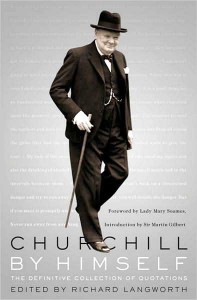 Churchill by Himself: The Definitive Collection of Quotations. London: Ebury Press and Random House; New York: Public Affairs, 2008. “What a drill sergeant of words he was, and what an outrage it was to let someone like him loose to embarrass and humiliate the rest of us mere mortal users of the language!….As a treasure trove of profound observations, rolling periods, amusing—often hilarious—one-liners, it threatens the hegemony of Bartlett’s Quotations. Legend has it that when Milton’s Paradise Lost was published, John Dryden said to fellow poets frequenting a coffee house, ‘This man cuts us all out, and the ancients too.’In the same way, all the collections of the ‘Wit and Wisdom of Churchill’ are now rendered automatically obsolete.” —Manfred Weidhorn.
Churchill by Himself: The Definitive Collection of Quotations. London: Ebury Press and Random House; New York: Public Affairs, 2008. “What a drill sergeant of words he was, and what an outrage it was to let someone like him loose to embarrass and humiliate the rest of us mere mortal users of the language!….As a treasure trove of profound observations, rolling periods, amusing—often hilarious—one-liners, it threatens the hegemony of Bartlett’s Quotations. Legend has it that when Milton’s Paradise Lost was published, John Dryden said to fellow poets frequenting a coffee house, ‘This man cuts us all out, and the ancients too.’In the same way, all the collections of the ‘Wit and Wisdom of Churchill’ are now rendered automatically obsolete.” —Manfred Weidhorn.
2000-08
 General Motors: 100 Years. Lincolnwood, Ill.: Publications International, 2008. Just in time for GM to get into trouble, but it survived. I’d rather depend on GM management than our rulers in Washington to run the company, which is now profitable again. I left the post-1980 story to the editors of Consumer Guide because I didn’t want to relive it. Each decade-long chapter begins with a quote. For 1970-79, I chose one by my old friend the late Tony Hogg, onetime editor of Road & Track: “GM is so big that if you started managing it very badly right now, you wouldn’t see the difference for ten years.” (Tony said that in 1973. Hmm.) Consumer Guide provides a beautiful array of color photographs.
General Motors: 100 Years. Lincolnwood, Ill.: Publications International, 2008. Just in time for GM to get into trouble, but it survived. I’d rather depend on GM management than our rulers in Washington to run the company, which is now profitable again. I left the post-1980 story to the editors of Consumer Guide because I didn’t want to relive it. Each decade-long chapter begins with a quote. For 1970-79, I chose one by my old friend the late Tony Hogg, onetime editor of Road & Track: “GM is so big that if you started managing it very badly right now, you wouldn’t see the difference for ten years.” (Tony said that in 1973. Hmm.) Consumer Guide provides a beautiful array of color photographs.
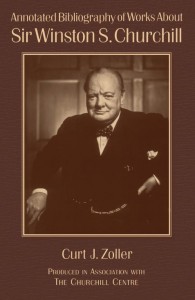 Annotated Bibliography of Works About Sir Winston S. Churchill (annotations for the book by Curt Zoller). Armonk, New York: M.E. Sharpe, 2004. Over 700 books have been written specifically about Churchill, and hundred more are in part devoted to him. To Curt Zoller’s comprehensive list including separate sections containing major articles and dissertations. I supplied capsule reviews of the 700 books about him, to help you know whether the a book is worth your time. Curt Zoller diligently compiled numerous sub-sections: books about Churchill, books kind of about him, articles in press and periodicals, reviews of WSC’s own books, dissertations and thesis. There are indices by author and title. My capsule reviews, updated to more recent titles, are also available online.
Annotated Bibliography of Works About Sir Winston S. Churchill (annotations for the book by Curt Zoller). Armonk, New York: M.E. Sharpe, 2004. Over 700 books have been written specifically about Churchill, and hundred more are in part devoted to him. To Curt Zoller’s comprehensive list including separate sections containing major articles and dissertations. I supplied capsule reviews of the 700 books about him, to help you know whether the a book is worth your time. Curt Zoller diligently compiled numerous sub-sections: books about Churchill, books kind of about him, articles in press and periodicals, reviews of WSC’s own books, dissertations and thesis. There are indices by author and title. My capsule reviews, updated to more recent titles, are also available online.
1996-1999
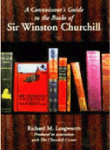 Connoisseur’s Guide to the Books of Sir Winston Churchill. London: Brasseys, 1998, rep. 2001. No rival to Ronald Cohen’s majestic and scholarly Bibliography of the Writings of Sir Winston Churchill, this was designed for book collectors, to illustrate, describe and evaluate from the standpoint of collector desirability and aesthetics the many different editions of Churchill’s nearly fifty books. Cohen Bibliography numbers are cross-referenced. Although hard copies are still available from Chartwell Booksellers, there is now an online Collector’s Guide from the same company.
Connoisseur’s Guide to the Books of Sir Winston Churchill. London: Brasseys, 1998, rep. 2001. No rival to Ronald Cohen’s majestic and scholarly Bibliography of the Writings of Sir Winston Churchill, this was designed for book collectors, to illustrate, describe and evaluate from the standpoint of collector desirability and aesthetics the many different editions of Churchill’s nearly fifty books. Cohen Bibliography numbers are cross-referenced. Although hard copies are still available from Chartwell Booksellers, there is now an online Collector’s Guide from the same company.
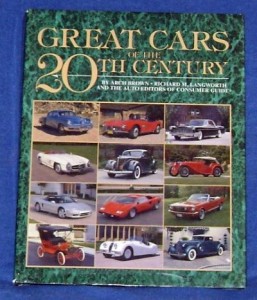 Great Cars of the 20th Century (with Arch Brown). Lincolnwood, Ill.: Publications Intl. 1998. German edition: Traumautos des 20. Jahrhunderts. Muller: 1998. This one is so rare that I can’t find an image of the dust jacket on the web. Nevertheless, the publisher had a good run out of it. There’s more than one way to skin a cat: Publications International just vacuumed all the articles Arch and I had written for them and threw this together with their usually excellent color photos. If you think of something as a “great car,” chances are it’s in here.
Great Cars of the 20th Century (with Arch Brown). Lincolnwood, Ill.: Publications Intl. 1998. German edition: Traumautos des 20. Jahrhunderts. Muller: 1998. This one is so rare that I can’t find an image of the dust jacket on the web. Nevertheless, the publisher had a good run out of it. There’s more than one way to skin a cat: Publications International just vacuumed all the articles Arch and I had written for them and threw this together with their usually excellent color photos. If you think of something as a “great car,” chances are it’s in here.
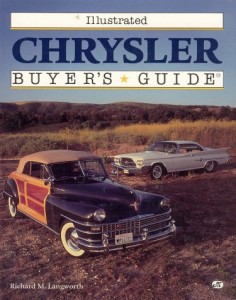 Illustrated Chrysler Buyer’s Guide, Osceola,Wis., Motorbooks International, 1996. The last (Thank God, you’re saying) of my paperback Buyer’s Guides, in which you must now ignore everything I said about prices and investment potential back in 1996. Two cars dominate interest in the postwar Chryslers: the Town & Country “lumber wagons” (convertibles in particular) built shortly after the war; and the 300 “Letter Series” which ran from 1955 to 1965. But Chrysler built many lesser models of great appeal to collectors, and the best of them are considered here.
Illustrated Chrysler Buyer’s Guide, Osceola,Wis., Motorbooks International, 1996. The last (Thank God, you’re saying) of my paperback Buyer’s Guides, in which you must now ignore everything I said about prices and investment potential back in 1996. Two cars dominate interest in the postwar Chryslers: the Town & Country “lumber wagons” (convertibles in particular) built shortly after the war; and the 300 “Letter Series” which ran from 1955 to 1965. But Chrysler built many lesser models of great appeal to collectors, and the best of them are considered here.
1993-95
Illustrated Dodge Buyer’s Guide, Osceola, Wis., Motorbooks International, 1995. The penultimate Buyer’s Guide for Motorbooks International. Pay no attention to what I said about the current values. Was there a Dodge worth buying before the Red Ram V-8? Possibly…I think so, but don’t hold me to it. Dodge built some great cars in the Fifties, Sixties, and Seventies. The best of them are here, with specs, production figures and photos.
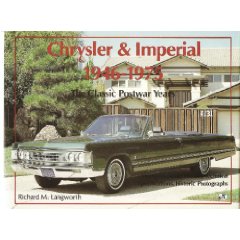 Chrysler and Imperial: The Classic Postwar Years. Osceola, Wis.: Motorbooks International, 1993. New updated edition of my second book (1976), but not extended to more recent models. Here’s the story of what happened to Walter Chrysler’s empire after World War II, when he wasn’t around to run it. Tracks the postwar renaissance under K.T. Keller (Chrysler was number two after GM until 1952), the near-failure in 1953-54, the Virgil Exner rebirth with the “Forward Look” of 1955, the age of tailfins and land yachts, the era of the Cordoba. Wonderful quotes from designers, stylists and executives.
Chrysler and Imperial: The Classic Postwar Years. Osceola, Wis.: Motorbooks International, 1993. New updated edition of my second book (1976), but not extended to more recent models. Here’s the story of what happened to Walter Chrysler’s empire after World War II, when he wasn’t around to run it. Tracks the postwar renaissance under K.T. Keller (Chrysler was number two after GM until 1952), the near-failure in 1953-54, the Virgil Exner rebirth with the “Forward Look” of 1955, the age of tailfins and land yachts, the era of the Cordoba. Wonderful quotes from designers, stylists and executives.
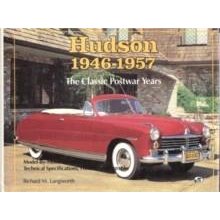 Hudson: The Classic Postwar Years 1946-1957. Osceola, Wis.: Motorbooks International, 1993. New edition of the 1977 original. Only one man, George Mason of Nash-Kelvinator, realized after World War II that the Big Three (GM, Chrysler, Ford) would eventually wipe out the small independents. Mason started courting Hudson in 1948, finally got them in 1953. Meanwhile he was encouraging Packard to merge with Studebaker, hoping to put them all together. He didn’t succeed, and the big Hudsons and Nashes vanished after 1957; but Hudson in those years produced unique cars by engineers who weren’t beholden to anybody, and Hudson also dominated NASCAR racing from 1952 to 1954.
Hudson: The Classic Postwar Years 1946-1957. Osceola, Wis.: Motorbooks International, 1993. New edition of the 1977 original. Only one man, George Mason of Nash-Kelvinator, realized after World War II that the Big Three (GM, Chrysler, Ford) would eventually wipe out the small independents. Mason started courting Hudson in 1948, finally got them in 1953. Meanwhile he was encouraging Packard to merge with Studebaker, hoping to put them all together. He didn’t succeed, and the big Hudsons and Nashes vanished after 1957; but Hudson in those years produced unique cars by engineers who weren’t beholden to anybody, and Hudson also dominated NASCAR racing from 1952 to 1954.
1992-93
 Studebaker 1946-1966: The Classic Postwar Years. Osceola, Wis.: Motorbooks International, 1993. New edition, updated, of Studebaker: The Postwar Years (1978). A twenty-year obituary, discussing how and why Studebaker went bad, lost money, merged with Packard, dragged Packard down with it, tried again with the Avanti and GT Hawk in the 1960s, but ultimately went belly up, after a sad two-year rump operation at its subsidiary plant in Hamilton, Ontario. In the process, Studebaker nevertheless created some memorable cars. See “Why Studebaker Failed” on this website.
Studebaker 1946-1966: The Classic Postwar Years. Osceola, Wis.: Motorbooks International, 1993. New edition, updated, of Studebaker: The Postwar Years (1978). A twenty-year obituary, discussing how and why Studebaker went bad, lost money, merged with Packard, dragged Packard down with it, tried again with the Avanti and GT Hawk in the 1960s, but ultimately went belly up, after a sad two-year rump operation at its subsidiary plant in Hamilton, Ontario. In the process, Studebaker nevertheless created some memorable cars. See “Why Studebaker Failed” on this website.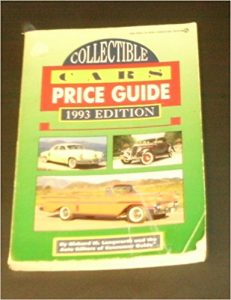
Collectible Cars Price Guide 1993. Lincolnwood, Illinois: Publications International; New York: Signet, 1992. It seemed like a good idea at the time, but unless they were willing to go the full periodical route (a field that’s already overpopulated), the publishers were doomed to find this book out of date almost from the moment of publication. It happened to arrive with a temporary deflation in collector car prices, which further affected the prices we so diligently researched from sales and auctions. Nice try but no cigar.
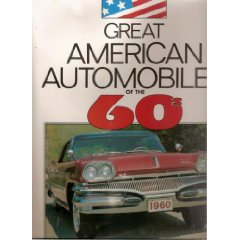 Great American Automobiles of the 60s (with James Flammang), Publications International, 1992. I don’t remember this book, but the publishers had a way of vacuuming the work of their authors and reissuing it, and I’m sure Flammang and I were the victims in this case; but maybe we were paid for it, I don’t remember. The publishers are responsible for the photographs, and they set a very high standard; look upon our written commentary as accompanying boilerplate.
Great American Automobiles of the 60s (with James Flammang), Publications International, 1992. I don’t remember this book, but the publishers had a way of vacuuming the work of their authors and reissuing it, and I’m sure Flammang and I were the victims in this case; but maybe we were paid for it, I don’t remember. The publishers are responsible for the photographs, and they set a very high standard; look upon our written commentary as accompanying boilerplate.
1990-91
 Illustrated Packard Buyer’s Guide. Osceola, Wis.: Motorbooks International, 1991. The prices are out of date now, but the interesting feature about this Packard entry in the Motorbooks Buyer’s Guide series is the “misery index” of troubles to watch for, which was created mostly by individual owners of the cars concerned. I think it’s still on the money as far as the most collectible Packards are concerned. Out of print but available online. Follow the link.
Illustrated Packard Buyer’s Guide. Osceola, Wis.: Motorbooks International, 1991. The prices are out of date now, but the interesting feature about this Packard entry in the Motorbooks Buyer’s Guide series is the “misery index” of troubles to watch for, which was created mostly by individual owners of the cars concerned. I think it’s still on the money as far as the most collectible Packards are concerned. Out of print but available online. Follow the link.
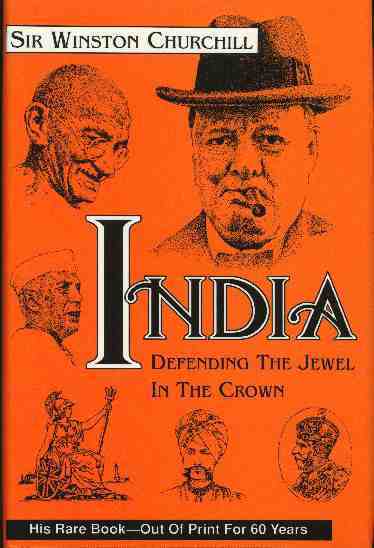 India, by Winston S. Churchill, India (publisher). First American Edition, Hopkinton, N.H.: Dragonwyck Publishing, 1991. In the speeches herein, Churchill led the die-hards in opposing the India Bill of the 1930s, which set India on the path (by no means assured) to independence. The bill passed and he lost with his usual good humor, sending a message to the Great Mahatma: “Tell Mr. Gandhi to use the powers that are offered and make the thing a success….I am genuinely sympathetic towards India….make a success and if you do I will advocate your getting much more.” A fire destroyed our remaining stock of 200 copies, and this book is now scarce, albeit much more affordable than the 1931 English edition.
India, by Winston S. Churchill, India (publisher). First American Edition, Hopkinton, N.H.: Dragonwyck Publishing, 1991. In the speeches herein, Churchill led the die-hards in opposing the India Bill of the 1930s, which set India on the path (by no means assured) to independence. The bill passed and he lost with his usual good humor, sending a message to the Great Mahatma: “Tell Mr. Gandhi to use the powers that are offered and make the thing a success….I am genuinely sympathetic towards India….make a success and if you do I will advocate your getting much more.” A fire destroyed our remaining stock of 200 copies, and this book is now scarce, albeit much more affordable than the 1931 English edition.
* * *
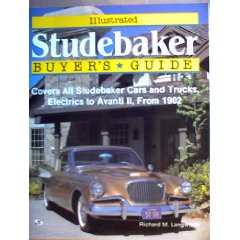 Illustrated Studebaker Buyer’s Guide. Osceola, Wis.: Motorbooks International, 1991. A survey that begins in 1902 with the Studebaker Electric and runs through the great pre-WW2 President Eights, the postwar Starlights and Starliners, the Hawks, Larks and on through the Avanti. With basic specifications, problem areas, histories of each model, and plentiful photographs.
Illustrated Studebaker Buyer’s Guide. Osceola, Wis.: Motorbooks International, 1991. A survey that begins in 1902 with the Studebaker Electric and runs through the great pre-WW2 President Eights, the postwar Starlights and Starliners, the Hawks, Larks and on through the Avanti. With basic specifications, problem areas, histories of each model, and plentiful photographs.
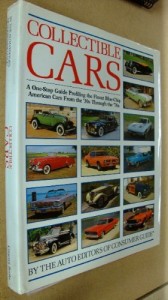 Collectible Cars (with Chris Poole). Lincolnwood, Illinois: Publications International; New York: Crescent, 1991. Another vacuum job by the Lincolnwood Linotypists, accompanied by excellent photographs. Random House said (and therefore must be right): “What makes a classic car? Why are some cars in demand while others are forgotten? Which cars are smart investments? These and other questions answered in this striking, expert, beautifully illustrated and up-to-date guide. 500 full-color photographs.” I enjoyed doing this beefy color tome with Chris Poole, one of the best editors I eve worked with.
Collectible Cars (with Chris Poole). Lincolnwood, Illinois: Publications International; New York: Crescent, 1991. Another vacuum job by the Lincolnwood Linotypists, accompanied by excellent photographs. Random House said (and therefore must be right): “What makes a classic car? Why are some cars in demand while others are forgotten? Which cars are smart investments? These and other questions answered in this striking, expert, beautifully illustrated and up-to-date guide. 500 full-color photographs.” I enjoyed doing this beefy color tome with Chris Poole, one of the best editors I eve worked with.
1989
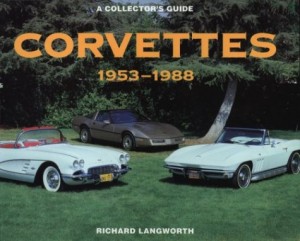 The Corvettes 1953-1988: A Collector’s Guide. Croydon: Surrey: Motor Racing Publications, 1989. A rundown from the collector’s standpoint of the several Corvette generations during the first thirty-five years of production, listing the highs, lows, joys and woes of ownership from Stove Bolt Six to Sting Ray to the modern era.
The Corvettes 1953-1988: A Collector’s Guide. Croydon: Surrey: Motor Racing Publications, 1989. A rundown from the collector’s standpoint of the several Corvette generations during the first thirty-five years of production, listing the highs, lows, joys and woes of ownership from Stove Bolt Six to Sting Ray to the modern era.
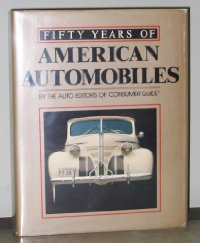 Fifty Years of American Automobiles 1939-1989. Lincolnwood, Illinois: Publications International; New York: Beekman House, Crescent Books, 1989. A huge, 786-page tome covering every American make from 1939 for the next half century. Nearly half of the book comprises specifications from my Encyclopedia of American Cars, but the strength of this heavy book is its hundreds of color photographs from the editors of Collectible Automobile. The publisher put this together from my previous work, not thinking it necessary to reward me with tuppence; I should have asked to be paid by the pound.
Fifty Years of American Automobiles 1939-1989. Lincolnwood, Illinois: Publications International; New York: Beekman House, Crescent Books, 1989. A huge, 786-page tome covering every American make from 1939 for the next half century. Nearly half of the book comprises specifications from my Encyclopedia of American Cars, but the strength of this heavy book is its hundreds of color photographs from the editors of Collectible Automobile. The publisher put this together from my previous work, not thinking it necessary to reward me with tuppence; I should have asked to be paid by the pound.
 Corvette: Portrait of a Legend. London: Smithmark Publishers, Macdonald, 1989. German edition: Heel, 1989. My Corvette histories are all built one on another. The difference with this one was 288 pages of landscape format, very heavy coated paper, and spectacular large format photography by the London publishers. Copies are plentiful on eBay: follow the link.
Corvette: Portrait of a Legend. London: Smithmark Publishers, Macdonald, 1989. German edition: Heel, 1989. My Corvette histories are all built one on another. The difference with this one was 288 pages of landscape format, very heavy coated paper, and spectacular large format photography by the London publishers. Copies are plentiful on eBay: follow the link.
1988
 Great American Automobiles of the 50s (with Chris Poole). Lincolnwood, Illinois: Publications International; New York: Beekman House, 1988. German edition: Amerikanische Automobile der 50er Jahre. Heel, 1991. Italian edition: Automobili americane degli anni Cinquanta. Nada, 1990. If you think the ’59 Cadillac rocketship is not a Great American Automobile, then I’m with you, but this is an exercise in reprinting the best photos of Fifties cars from Collectible Automobile, and Chris and I wrote the stories to go with the pix they selected. Its 320 pages are packed with color.
Great American Automobiles of the 50s (with Chris Poole). Lincolnwood, Illinois: Publications International; New York: Beekman House, 1988. German edition: Amerikanische Automobile der 50er Jahre. Heel, 1991. Italian edition: Automobili americane degli anni Cinquanta. Nada, 1990. If you think the ’59 Cadillac rocketship is not a Great American Automobile, then I’m with you, but this is an exercise in reprinting the best photos of Fifties cars from Collectible Automobile, and Chris and I wrote the stories to go with the pix they selected. Its 320 pages are packed with color.
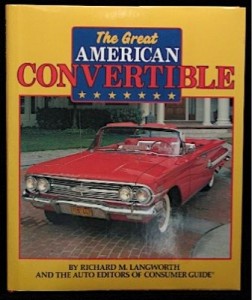 The Great American Convertible. Lincolnwood, Illinois: Publications International; New York: Beekman House, 1988. A survey of the convertible, from its development out of the roadster and phaeton in the 1930s to the supposed end of production in America in the 1970s. A British reviewer complained that it was too technical, and too given to production figures, a legitimate complaint. There wasn’t time to write a lyrical history, though one should be written.
The Great American Convertible. Lincolnwood, Illinois: Publications International; New York: Beekman House, 1988. A survey of the convertible, from its development out of the roadster and phaeton in the 1930s to the supposed end of production in America in the 1970s. A British reviewer complained that it was too technical, and too given to production figures, a legitimate complaint. There wasn’t time to write a lyrical history, though one should be written.
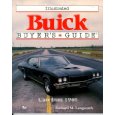 Illustrated Buick Buyer’s Guide. Osceola, Wis.: Motorbooks International, 1988. For amusing reviews (and retorts by the author) click the link and then click the review link. Hell hath no fury like a buff whose favorite is left out! But the funniest is by a guy who doesn’t know me but knows my son, and since my son is admirable, he’s sure the book is! A more serious Buick collector recently noted that I predicted the best Gran Sports would break $50,000, and they’re not even at $25,000 today—which is one more proof that you never want to look at prices or projections in decades-old buyers guides.
Illustrated Buick Buyer’s Guide. Osceola, Wis.: Motorbooks International, 1988. For amusing reviews (and retorts by the author) click the link and then click the review link. Hell hath no fury like a buff whose favorite is left out! But the funniest is by a guy who doesn’t know me but knows my son, and since my son is admirable, he’s sure the book is! A more serious Buick collector recently noted that I predicted the best Gran Sports would break $50,000, and they’re not even at $25,000 today—which is one more proof that you never want to look at prices or projections in decades-old buyers guides.
1987
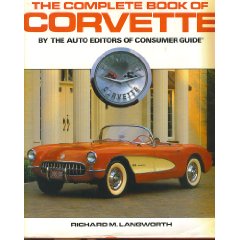 The Complete Book of Corvette. New York: Beekman House, 1987. Takes the story up through 1988, with a new assortment of fine Corvette photos from the auto editors of Consumer Guide. My second Corvette book; they came thick and fast after this one, but I think Consumer Guide did an excellent job with the layout and photography.
The Complete Book of Corvette. New York: Beekman House, 1987. Takes the story up through 1988, with a new assortment of fine Corvette photos from the auto editors of Consumer Guide. My second Corvette book; they came thick and fast after this one, but I think Consumer Guide did an excellent job with the layout and photography.
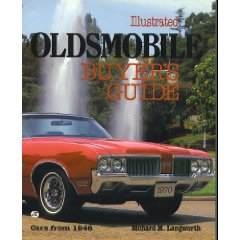 Illustrated Oldsmobile Buyer’s Guide. Osceola, Wis.: Motorbooks International, 1987. Amazon offers an interesting customer review: “Although an interesting read, this book has very limited application for me. [But I’m glad it was interesting.] The years and models reviewed have been subjectively selected [You think?] and the amount of information on each is uneven and, in my opinion, inadequate. As a current Oldsmobile owner [Current?] I am much more interested in what options were available…” [You want a technical manual, not a buyer’s guide.]
Illustrated Oldsmobile Buyer’s Guide. Osceola, Wis.: Motorbooks International, 1987. Amazon offers an interesting customer review: “Although an interesting read, this book has very limited application for me. [But I’m glad it was interesting.] The years and models reviewed have been subjectively selected [You think?] and the amount of information on each is uneven and, in my opinion, inadequate. As a current Oldsmobile owner [Current?] I am much more interested in what options were available…” [You want a technical manual, not a buyer’s guide.]
 The Complete History of Ford Motor Company (with Graham Robson). Skokie, Illinois: Publications International; New York: Beekman House, 1987. A product history of Ford, Mercury and Lincoln covering the first seventy-five years of production. Extensive text with large sections of color photographs from Collectible Automobile magazine.
The Complete History of Ford Motor Company (with Graham Robson). Skokie, Illinois: Publications International; New York: Beekman House, 1987. A product history of Ford, Mercury and Lincoln covering the first seventy-five years of production. Extensive text with large sections of color photographs from Collectible Automobile magazine.
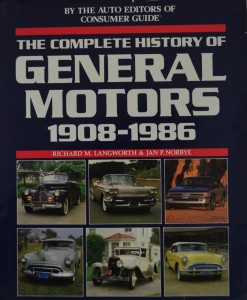 The Complete History of General Motors 1908-1986 (with Jan P. Norbye). Skokie, Illinois: Publications International,1987. Capitalized with one thousand dollars, it grew into the mightiest industrial leviathan, only to come a-crashing down. A product history of Buick,Cadillac, Oldsmobile, Oakland and Pontiac, documented by an extensive decade-by-decade text and large sections of color photographs from Collectible Automobile. Yipes: someone is offering a copy for $840!
The Complete History of General Motors 1908-1986 (with Jan P. Norbye). Skokie, Illinois: Publications International,1987. Capitalized with one thousand dollars, it grew into the mightiest industrial leviathan, only to come a-crashing down. A product history of Buick,Cadillac, Oldsmobile, Oakland and Pontiac, documented by an extensive decade-by-decade text and large sections of color photographs from Collectible Automobile. Yipes: someone is offering a copy for $840!
1984-86
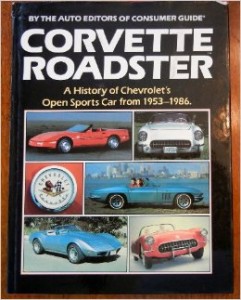 Corvette Roadster: A History of Chevrolet’s Open Sports Car from 1953-1986. London: Haynes, 1986; Skokie, Illinois: Publications International, 1986. A 64-page hardback proving that you don’t have to say everything to sell a book on Corvettes. In this case we concentrated on the open models, which were not strictly roadsters but convertibles, but nobody much worries. Easily acquired, but expect no new information.
Corvette Roadster: A History of Chevrolet’s Open Sports Car from 1953-1986. London: Haynes, 1986; Skokie, Illinois: Publications International, 1986. A 64-page hardback proving that you don’t have to say everything to sell a book on Corvettes. In this case we concentrated on the open models, which were not strictly roadsters but convertibles, but nobody much worries. Easily acquired, but expect no new information.
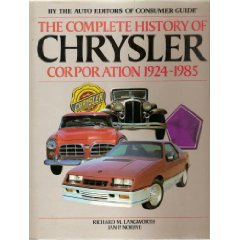 The Complete History of Chrysler Corporation 1924-1985 (with Jan P. Norbye). Skokie, Illinois: Publications International; New York: Beekman House, 1986. This book was fun to write, chiefly because my co-author was the late, great tech writer Jan Norbye, whose engineering expertise proved indispensible to the story of the engineer-dominated company. Covered all models from the first, and all makes from Plymouth to Imperial, in color and black and white photos.
The Complete History of Chrysler Corporation 1924-1985 (with Jan P. Norbye). Skokie, Illinois: Publications International; New York: Beekman House, 1986. This book was fun to write, chiefly because my co-author was the late, great tech writer Jan Norbye, whose engineering expertise proved indispensible to the story of the engineer-dominated company. Covered all models from the first, and all makes from Plymouth to Imperial, in color and black and white photos.
* * *
 Illustrated Cadillac Buyer’s Guide. Osceola, Wisconsin: Motorbooks International, 1986. Second edition, 1993. This guide covered postwar models only, with the help of Bud Juneau and other Cadillac collectors, who supplied firsthand information of problem areas and what to look for in buying an old Cadillac.
Illustrated Cadillac Buyer’s Guide. Osceola, Wisconsin: Motorbooks International, 1986. Second edition, 1993. This guide covered postwar models only, with the help of Bud Juneau and other Cadillac collectors, who supplied firsthand information of problem areas and what to look for in buying an old Cadillac.
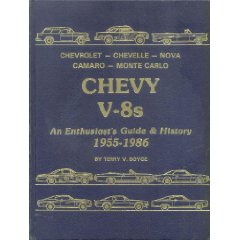 Chevy V-8s 1955-1986: An Enthusiast’s Guide and History, by Terry Boyce (publisher). Hopkinton, N.H.: Dragonwyck Publishing, 1986. Second and last of our “National Heritage Series” of deluxe photo-documentaries. What’s more popular than a Chevy V-8? Terry Boyce provided expert commentary and captions to the hundreds of photos, but the subject was too general, not specific enough. It was not as successful as The Studebaker Century (below).
Chevy V-8s 1955-1986: An Enthusiast’s Guide and History, by Terry Boyce (publisher). Hopkinton, N.H.: Dragonwyck Publishing, 1986. Second and last of our “National Heritage Series” of deluxe photo-documentaries. What’s more popular than a Chevy V-8? Terry Boyce provided expert commentary and captions to the hundreds of photos, but the subject was too general, not specific enough. It was not as successful as The Studebaker Century (below).
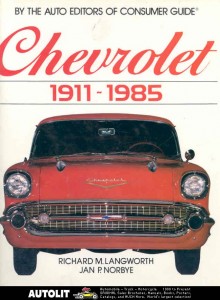 Chevrolet 1911-1985 (with Jan P. Norbye). Skokie, Illinois: Publications International; New York: Beekman House, 1984. Nobody surpassed the late Jan Norbye for technical expertise, and writing this history of Chevrolet with Jan was a joy. From the early machinations of Louis Chevrolet to the Ford rivalry, the Stovebolt Six, the “classic” 55-57s, the supercars, and the land whales of the 1980s; 384 pages with color photography of hundreds of models from the pages of Collectible Automobile.
Chevrolet 1911-1985 (with Jan P. Norbye). Skokie, Illinois: Publications International; New York: Beekman House, 1984. Nobody surpassed the late Jan Norbye for technical expertise, and writing this history of Chevrolet with Jan was a joy. From the early machinations of Louis Chevrolet to the Ford rivalry, the Stovebolt Six, the “classic” 55-57s, the supercars, and the land whales of the 1980s; 384 pages with color photography of hundreds of models from the pages of Collectible Automobile.
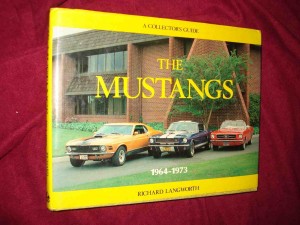 The Mustangs, 1964-1973: A Collector’s Guide.London: Motor Racing Publications, 1984. Second edition, paperback, 1992. Jon Blunsden of MRP took a flyer on a Mustang book for the British market, in his high-selling Collector’s Guide series. The book did well over two editions, covering the “classic” Mustangs of 1965-69 thoroughly. Contrary to what is endlessly repeated, there was no “1964 1/2” Mustang, though the ’65 was introduced in the Spring of 1964.
The Mustangs, 1964-1973: A Collector’s Guide.London: Motor Racing Publications, 1984. Second edition, paperback, 1992. Jon Blunsden of MRP took a flyer on a Mustang book for the British market, in his high-selling Collector’s Guide series. The book did well over two editions, covering the “classic” Mustangs of 1965-69 thoroughly. Contrary to what is endlessly repeated, there was no “1964 1/2” Mustang, though the ’65 was introduced in the Spring of 1964.
* * *
 Encyclopedia of American Cars 1930-1980. Skokie, Illinois: Publications International; New York: Beekman House, 1984. Multiple revised and extended editions through 2007. Covers every major and minor make; the majors have detailed tables of specifications, original prices and production figures; the text covers their history. Amazon reviewers rate it 4 1/2 stars: “…the ultimate book for the ultimate car lover. It has it all, best of its kind, I have several of these car books and this by far is the best”….My husband had to buy two of them because our son stole his last time he came home And he wouldn’t give it back.”
Encyclopedia of American Cars 1930-1980. Skokie, Illinois: Publications International; New York: Beekman House, 1984. Multiple revised and extended editions through 2007. Covers every major and minor make; the majors have detailed tables of specifications, original prices and production figures; the text covers their history. Amazon reviewers rate it 4 1/2 stars: “…the ultimate book for the ultimate car lover. It has it all, best of its kind, I have several of these car books and this by far is the best”….My husband had to buy two of them because our son stole his last time he came home And he wouldn’t give it back.”
 Mercedes-Benz: The First Hundred Years. Skokie, Illinois: Publications International; New York: Beekman House, 1984. Abridged edition: Consumer Guide Classic Car Series, October 1984. German edition: Serag, 1986. I loved writing about the great racing cars, particularly the silver bullets that dominated Grand Prix racing in the 1930s. Neither a comprehensive nor a huge book, but the photos do justice to a grand marque that earned its reputation over the past century.
Mercedes-Benz: The First Hundred Years. Skokie, Illinois: Publications International; New York: Beekman House, 1984. Abridged edition: Consumer Guide Classic Car Series, October 1984. German edition: Serag, 1986. I loved writing about the great racing cars, particularly the silver bullets that dominated Grand Prix racing in the 1930s. Neither a comprehensive nor a huge book, but the photos do justice to a grand marque that earned its reputation over the past century.
 Porsche, a Tradition of Greatness. Skokie, Illinois: Publications International; New York: Beekman House, 1983. Abridged edition: Consumer Guide Classic Car Series, March 1984. German edition: Porsche: Die Geschichter einer Denkfabrik. Pfaffikon, Germany: Serag, n.d. [1984]. Every other Porsche book stands in the shadow of Karl Ludvigsen (Porsche: Excellence Was Expected). Within only 250 pages, we had nowhere near the depth of Karl’s deservedly famous standard work on Porsche.
Porsche, a Tradition of Greatness. Skokie, Illinois: Publications International; New York: Beekman House, 1983. Abridged edition: Consumer Guide Classic Car Series, March 1984. German edition: Porsche: Die Geschichter einer Denkfabrik. Pfaffikon, Germany: Serag, n.d. [1984]. Every other Porsche book stands in the shadow of Karl Ludvigsen (Porsche: Excellence Was Expected). Within only 250 pages, we had nowhere near the depth of Karl’s deservedly famous standard work on Porsche.
1982-83
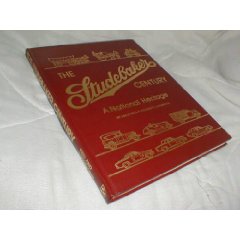 The Studebaker Century: A National Heritage (publisher and co-author with Asa E. Hall). Hopkinton, N.H.: Dragonwyck Publishing, 1983. The late Asa Hall’s comprehensive collection of photos from the covered wagon to the Avanti was the inspiration of this deluxe photo-documentary, printed on fine cream enamel, with illustrations by Russ von Sauers and a gilt stamped cover. A limited edition, now rare, was offered in padded leather with gilt page edges and silk page marker. Covers Studebaker’s entire 114-year history with detailed captions for the hundreds of photos published here for the first time.
The Studebaker Century: A National Heritage (publisher and co-author with Asa E. Hall). Hopkinton, N.H.: Dragonwyck Publishing, 1983. The late Asa Hall’s comprehensive collection of photos from the covered wagon to the Avanti was the inspiration of this deluxe photo-documentary, printed on fine cream enamel, with illustrations by Russ von Sauers and a gilt stamped cover. A limited edition, now rare, was offered in padded leather with gilt page edges and silk page marker. Covers Studebaker’s entire 114-year history with detailed captions for the hundreds of photos published here for the first time.
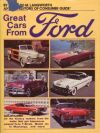 Great Cars from Ford. Skokie, Illinois: Publications International, 1982. Proof positive of “enduring worth” is that one of these 96-page potboilers is offered for over $80. It was just a workaday survey of the obvious Ford greats (most of them postwar) over the years, assembled with some nice photography. Nothing to write home about.
Great Cars from Ford. Skokie, Illinois: Publications International, 1982. Proof positive of “enduring worth” is that one of these 96-page potboilers is offered for over $80. It was just a workaday survey of the obvious Ford greats (most of them postwar) over the years, assembled with some nice photography. Nothing to write home about.
 Mustang Encyclopedia (with Barbara Langworth, Greg Wells, Rick Kopec). Skokie, Illinois: Publications Internaitonal, 1982. A compendium of Mustangiana, incuding a restorer’s guide, a guide to the multiple accessories that made the Mustang so many different cars to so many different people; and a source guide for further information. Detailed model specifications through the 1980 model.
Mustang Encyclopedia (with Barbara Langworth, Greg Wells, Rick Kopec). Skokie, Illinois: Publications Internaitonal, 1982. A compendium of Mustangiana, incuding a restorer’s guide, a guide to the multiple accessories that made the Mustang so many different cars to so many different people; and a source guide for further information. Detailed model specifications through the 1980 model.
1981-82
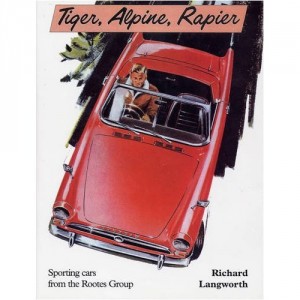 Tiger, Alpine, Rapier: Sporting Cars from the Rootes Group. London: London, Osprey, 1982, rep. London: Mercian Manuals, 1999. The Rootes Group (Hillman, Sunbeam-Talbot, Singer, Humber) was an odd bunch from the start and their sporting cars were sometimes bizarre: a sports car with tailfins, another with a Ford engine sold by Chrysler, a hardtop painted Neapolitan ice cream colors (Rapier). The oddly named Humber Super Snipe, said Michael Sedgwick, “induced mal de mer on the motorway” but did great things on the East African Safari. A jolly tale of racing and rallying in the days when you could do it on a shoestring. (Stirling Moss told Graham Robson: “You wouldn’t believe how slow my Alpines were.” Graham replied: “Yes I would!”) See also the Harrington Harangue.
Tiger, Alpine, Rapier: Sporting Cars from the Rootes Group. London: London, Osprey, 1982, rep. London: Mercian Manuals, 1999. The Rootes Group (Hillman, Sunbeam-Talbot, Singer, Humber) was an odd bunch from the start and their sporting cars were sometimes bizarre: a sports car with tailfins, another with a Ford engine sold by Chrysler, a hardtop painted Neapolitan ice cream colors (Rapier). The oddly named Humber Super Snipe, said Michael Sedgwick, “induced mal de mer on the motorway” but did great things on the East African Safari. A jolly tale of racing and rallying in the days when you could do it on a shoestring. (Stirling Moss told Graham Robson: “You wouldn’t believe how slow my Alpines were.” Graham replied: “Yes I would!”) See also the Harrington Harangue.
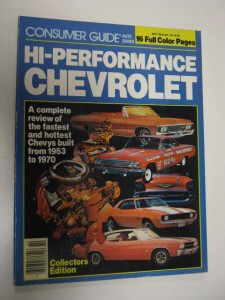 Hi-Performance Chevrolet. Skokie, Illinois: Publications International, 1981. A 96-page potboiler on “the fastest and hottest Chevys built from 1953 through 1970. From the development of the original Chevy V-8 through the age of the SS 409, with 16 pages in color.
Hi-Performance Chevrolet. Skokie, Illinois: Publications International, 1981. A 96-page potboiler on “the fastest and hottest Chevys built from 1953 through 1970. From the development of the original Chevy V-8 through the age of the SS 409, with 16 pages in color.
 Camaro. Skokie, Illinois: Publications International; Secaucus, N.J.: Castle Books, 1981. Classic Car Bimonthly, July 1983. The Corvair couldn’t compete with the Mustang, so Chevrolet turned its attention to a conventional layout with the Camaro, which saw some of the hottest Chevys during its early years. Ninety-six pages with 16 in color.
Camaro. Skokie, Illinois: Publications International; Secaucus, N.J.: Castle Books, 1981. Classic Car Bimonthly, July 1983. The Corvair couldn’t compete with the Mustang, so Chevrolet turned its attention to a conventional layout with the Camaro, which saw some of the hottest Chevys during its early years. Ninety-six pages with 16 in color.
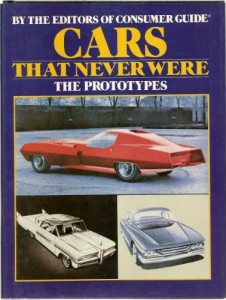 Cars That Never Were: The Prototypes. Skokie, Illinois: Publications International; New York: Beekman House, 1981. Proposed, stillborn, and show car specials by the American Big Three and the indepents, the usual 96-pager with 16 pages of color. From the Packard Predictor and stillborn line of big ’57 Packards, to the umpteenth facelift of Dutch Darrin’s 1951 Kaiser, to GM Motorama cars and swoopy Mopar one-offs: the book proved eclectic a mix to generate much sales, and is today rare.
Cars That Never Were: The Prototypes. Skokie, Illinois: Publications International; New York: Beekman House, 1981. Proposed, stillborn, and show car specials by the American Big Three and the indepents, the usual 96-pager with 16 pages of color. From the Packard Predictor and stillborn line of big ’57 Packards, to the umpteenth facelift of Dutch Darrin’s 1951 Kaiser, to GM Motorama cars and swoopy Mopar one-offs: the book proved eclectic a mix to generate much sales, and is today rare.
1980
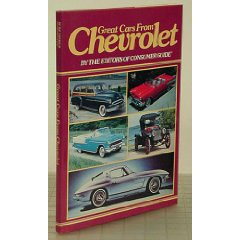 Great Cars from Chevrolet. Skokie, Illinois: Publications International; Secaucus, N.J.: Castle Books, 1980. This book looks at the most interesting Chevrolets from the beginning in 1911, but emphasis is on the postwar: the fabulous ’55 V-8, Corvette, Corvair, Camaro, Montecarlo, Super Sports and early Impalas. Ninety-six pages with 16 in color. Now scarce.
Great Cars from Chevrolet. Skokie, Illinois: Publications International; Secaucus, N.J.: Castle Books, 1980. This book looks at the most interesting Chevrolets from the beginning in 1911, but emphasis is on the postwar: the fabulous ’55 V-8, Corvette, Corvair, Camaro, Montecarlo, Super Sports and early Impalas. Ninety-six pages with 16 in color. Now scarce.
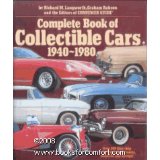 Complete Book of Collectible Cars 1940-1970 (with Graham Robson). Skokie, Illinois: Publications International, 1980. Revised and extended editions: 1940-1980 (1982); 1930-1980 (1985, revised 1987); 1930-1990 (1992). Graham and I chose several hundred highly collectible American, British, German, Italian and other cars and supplied thumbnail histories, pros and cons, brief specifications, production figures, pithy critiques and even current values (they were cheap then). Gold standards like Corvette, Packard, Rolls-Royce, Porsche and Ferrari mixed with oddballs like Humber, Frazer, Gogomobil and Amphicar. Consumer Guide paid us (once), issued reprint after reprint, and the book is still around, now extended to cover cars through 1990.
Complete Book of Collectible Cars 1940-1970 (with Graham Robson). Skokie, Illinois: Publications International, 1980. Revised and extended editions: 1940-1980 (1982); 1930-1980 (1985, revised 1987); 1930-1990 (1992). Graham and I chose several hundred highly collectible American, British, German, Italian and other cars and supplied thumbnail histories, pros and cons, brief specifications, production figures, pithy critiques and even current values (they were cheap then). Gold standards like Corvette, Packard, Rolls-Royce, Porsche and Ferrari mixed with oddballs like Humber, Frazer, Gogomobil and Amphicar. Consumer Guide paid us (once), issued reprint after reprint, and the book is still around, now extended to cover cars through 1990.
* * *
 Cadillac: Standard of Excellence 1903-1980. Skokie, Illinois: Publications International; Secaucus, N.J.: Castle Books, 1980. A marque history in the Consumer Guide 96-page series, with a broad-brush treatment of the Cadillac story. In the days when I pursued the Detroit beat, it was always fun to visit the grand old plant at Clark Avenue, where an aura of permanence was accompanied by a gracious assertion of supremacy. Those were the days.
Cadillac: Standard of Excellence 1903-1980. Skokie, Illinois: Publications International; Secaucus, N.J.: Castle Books, 1980. A marque history in the Consumer Guide 96-page series, with a broad-brush treatment of the Cadillac story. In the days when I pursued the Detroit beat, it was always fun to visit the grand old plant at Clark Avenue, where an aura of permanence was accompanied by a gracious assertion of supremacy. Those were the days.
 Cars of the 30s. Skokie, Illinois: Publications International; New York: Beekman House, 1980. Despite a threadbare economy, the American industry reached its finest flowering in this final decade of the classic era. Last-ditch efforts from firms such as Auburn, Cord, Duesenberg and Pierce-Arrow vied with some of the better models of survivors such as Cadillac, Packard, Lincoln and the Chrysler Imperial.
Cars of the 30s. Skokie, Illinois: Publications International; New York: Beekman House, 1980. Despite a threadbare economy, the American industry reached its finest flowering in this final decade of the classic era. Last-ditch efforts from firms such as Auburn, Cord, Duesenberg and Pierce-Arrow vied with some of the better models of survivors such as Cadillac, Packard, Lincoln and the Chrysler Imperial.
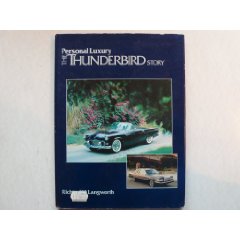 Personal Luxury: The Thunderbird Story. Osceola, Wis.: Motorbooks International, 1980. Bill Boyer, who largely created the original two-seater, told me where the famous portholes came from: off the boat of Gene Bordinat of Ford Styling, when Bill happened to take a cruise on Lake Michigan. “It seemed like a neat solution to the visibility problem of the optional hardtop.” That was how things were done in those days! Large scale format and hundreds of photos characterize this book which goes through 1980 but mainly concentrates on the 1950s and 1960s models.
Personal Luxury: The Thunderbird Story. Osceola, Wis.: Motorbooks International, 1980. Bill Boyer, who largely created the original two-seater, told me where the famous portholes came from: off the boat of Gene Bordinat of Ford Styling, when Bill happened to take a cruise on Lake Michigan. “It seemed like a neat solution to the visibility problem of the optional hardtop.” That was how things were done in those days! Large scale format and hundreds of photos characterize this book which goes through 1980 but mainly concentrates on the 1950s and 1960s models.
1970-79
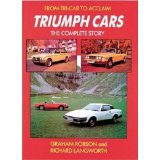 Triumph Cars: The Complete Story. (with Graham Robson. Link is to the new 2018 edition). London: Motor Racing Publishers, 1979, rep. 1998, together with a deluxe leatherbound limited edition. A wonderful undertaking with my dear friend Graham, in which I took the prewar history and a few postwar chapters, and Graham the rest. The late Michael Sedgwick, God bless him, wrote: “I should have thought Langworth was English; no American could know so much about the way it was here in the years between the world wars.”
Triumph Cars: The Complete Story. (with Graham Robson. Link is to the new 2018 edition). London: Motor Racing Publishers, 1979, rep. 1998, together with a deluxe leatherbound limited edition. A wonderful undertaking with my dear friend Graham, in which I took the prewar history and a few postwar chapters, and Graham the rest. The late Michael Sedgwick, God bless him, wrote: “I should have thought Langworth was English; no American could know so much about the way it was here in the years between the world wars.”
 Cars of the 60s. Skokie, Illinois: Publications International; New York: Beekman House, 1979. The independents were gone, but the Sixties saw a blossoming of the Big Three and American Motors. This book tells the story of the decade from the new Detroit “compacts” through the sporty compacts, the Mustang and Camaro, the muscle cars and luxury makes from the Imperial Southampton to the four-door-convertible Continentals and Cadillac Eldorados.
Cars of the 60s. Skokie, Illinois: Publications International; New York: Beekman House, 1979. The independents were gone, but the Sixties saw a blossoming of the Big Three and American Motors. This book tells the story of the decade from the new Detroit “compacts” through the sporty compacts, the Mustang and Camaro, the muscle cars and luxury makes from the Imperial Southampton to the four-door-convertible Continentals and Cadillac Eldorados.
1979
 The American Sports Car. Skokie, Illinois: Publications International; New York: Beekman House, 1979. We begin with the original Yankee sports cars: the Mercer Raceabout and the Stutz Bearcat. The story moves through the sports car revival after World War II, the birth of the Nash-Healey, Woodill Wildfire, Kaiser Darrin, Corvette and Thunderbird, and on through the great Shelby sports cars of the Sixties and Seventies.
The American Sports Car. Skokie, Illinois: Publications International; New York: Beekman House, 1979. We begin with the original Yankee sports cars: the Mercer Raceabout and the Stutz Bearcat. The story moves through the sports car revival after World War II, the birth of the Nash-Healey, Woodill Wildfire, Kaiser Darrin, Corvette and Thunderbird, and on through the great Shelby sports cars of the Sixties and Seventies.
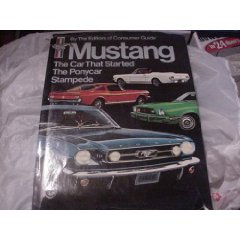 Mustang: The Car That Started the Ponycar Stampede. Skokie, Illinois: Publications International; New York: Beekman House, 1979. “Sure I invented the Mustang,” Lee Iacocca. I’ll tell you that anytime. But ask around for who invented the Edsel. That’s like old Diogenes with his lantern, searching for an honest man! Dozens of styling phots that show the evolution of each Mustang. Includes Shelby Mustang, Boss 302, MachI and competition cars, with driving impressions of the best models.
Mustang: The Car That Started the Ponycar Stampede. Skokie, Illinois: Publications International; New York: Beekman House, 1979. “Sure I invented the Mustang,” Lee Iacocca. I’ll tell you that anytime. But ask around for who invented the Edsel. That’s like old Diogenes with his lantern, searching for an honest man! Dozens of styling phots that show the evolution of each Mustang. Includes Shelby Mustang, Boss 302, MachI and competition cars, with driving impressions of the best models.
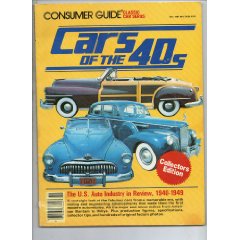 Cars of the 40s. Skokie, Illinois: Publications International; New York: Beekman House, 1979. Surveys the decade, including prewar orphans (LaSalle, Hupp, Graham) and postwar shooting stars (Frazer, Tucker, Kaiser), along with the Big Three and major independents. The most versatile Forties make was Willys, who began the decade as a cheap economy car and ended up with civilian versions of the wartime Jeep.
Cars of the 40s. Skokie, Illinois: Publications International; New York: Beekman House, 1979. Surveys the decade, including prewar orphans (LaSalle, Hupp, Graham) and postwar shooting stars (Frazer, Tucker, Kaiser), along with the Big Three and major independents. The most versatile Forties make was Willys, who began the decade as a cheap economy car and ended up with civilian versions of the wartime Jeep.
1978
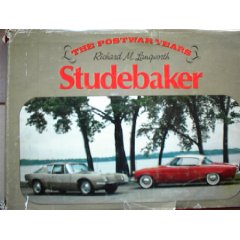 Studebaker: The Postwar Years. Osceola,Wis.: Motorbooks International, 1978. A twenty-year obituary of how and why Studebaker went bad, lost money, merged with Packard, dragged Packard down with it, tried again with the Avanti and GT Hawk in the 1960s, but ultimately went belly up, after a sad two-year rump operation at its subsidiary plant in Hamilton, Ontario. In the process, Studebaker nevertheless created some memorable cars. See “Why Studebaker Failed” on this website.
Studebaker: The Postwar Years. Osceola,Wis.: Motorbooks International, 1978. A twenty-year obituary of how and why Studebaker went bad, lost money, merged with Packard, dragged Packard down with it, tried again with the Avanti and GT Hawk in the 1960s, but ultimately went belly up, after a sad two-year rump operation at its subsidiary plant in Hamilton, Ontario. In the process, Studebaker nevertheless created some memorable cars. See “Why Studebaker Failed” on this website.
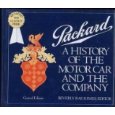 Packard: A History of the Motorcar and the Company (co-editor, with Beverly Rae Kimes and author of two chapters). New York: Dutton, 1978-date. Cugnot Award, Society of Automotive Historians. A mammoth, multi-author undertaking, the joy of which was spoiled somewhat by in-house quarreling, but we all figured out the source and were friends in the end. By far the most comprehensive history of Packard; the later bindings hold up much better than the flimsy original.
Packard: A History of the Motorcar and the Company (co-editor, with Beverly Rae Kimes and author of two chapters). New York: Dutton, 1978-date. Cugnot Award, Society of Automotive Historians. A mammoth, multi-author undertaking, the joy of which was spoiled somewhat by in-house quarreling, but we all figured out the source and were friends in the end. By far the most comprehensive history of Packard; the later bindings hold up much better than the flimsy original.
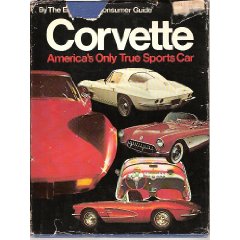 Corvette: America’s Only True Sports Car. Skokie, Illinois: Publications International; New York: Beekman House, 1978. The first of a long string of Corvette books, each building upon the other. Traces the American sports car back to the Mercer Raceabout and Stutz Bearcat. At Carlisle, when my wife asked a customer if he would like his copy signed, he asked: “By whom?” Ah, fickle fame.
Corvette: America’s Only True Sports Car. Skokie, Illinois: Publications International; New York: Beekman House, 1978. The first of a long string of Corvette books, each building upon the other. Traces the American sports car back to the Mercer Raceabout and Stutz Bearcat. At Carlisle, when my wife asked a customer if he would like his copy signed, he asked: “By whom?” Ah, fickle fame.
* * *
 Cars of the 50s. Skokie, Illinois: Publications International; New York: Beekman House, 1978. Consumer Guide issue, April 1980. I think the publishers have produced a half dozen different books by this title. Mine surveyed the ranks of Detroit in a decade marked by the horsepower race, the hardtop convertible, the all-steel station wagon, tailfins and torsion bars, and the advent of high style in 1955.
Cars of the 50s. Skokie, Illinois: Publications International; New York: Beekman House, 1978. Consumer Guide issue, April 1980. I think the publishers have produced a half dozen different books by this title. Mine surveyed the ranks of Detroit in a decade marked by the horsepower race, the hardtop convertible, the all-steel station wagon, tailfins and torsion bars, and the advent of high style in 1955.
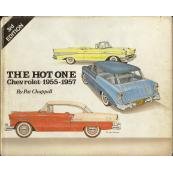 The Hot One: Chevrolet 1955-57, by Pat Chappell (publisher). Hopkinton, N.H.: Dragonwyck Publishing, 1978, five reprints. Pat Chapell backed reluctantly into “classic” Chevys because her husband was crazy about them, and got to like them so much that she researched their complete history. Her book had five printings, and is sought after today. The one to look for has a silver binding, which marked the twenty-fifty anniversary of the ’55 Chevy in 1980. We are now working on a Kindle edition.
The Hot One: Chevrolet 1955-57, by Pat Chappell (publisher). Hopkinton, N.H.: Dragonwyck Publishing, 1978, five reprints. Pat Chapell backed reluctantly into “classic” Chevys because her husband was crazy about them, and got to like them so much that she researched their complete history. Her book had five printings, and is sought after today. The one to look for has a silver binding, which marked the twenty-fifty anniversary of the ’55 Chevy in 1980. We are now working on a Kindle edition.
1977
 Hudson: The Postwar Years. Osceola,Wis.: Motorbooks International, 1977. Only one man, George Mason of Nash-Kelvinator, realized after World War II that the Big Three (GM, Chrysler, Ford) would eventually wipe out the small independents. Mason started courting Hudson in 1948, finally got them in 1953. Meanwhile he was encouraging Packard to merger with Studebaker, hoping to put them all together. He didn’t succeed, and the big Hudsons and Nashes vanished after 1957; but Hudson in those years produced unique cars by engineers who weren’t beholden to anybody, and dominated NASCAR racing from 1952 to 1954.
Hudson: The Postwar Years. Osceola,Wis.: Motorbooks International, 1977. Only one man, George Mason of Nash-Kelvinator, realized after World War II that the Big Three (GM, Chrysler, Ford) would eventually wipe out the small independents. Mason started courting Hudson in 1948, finally got them in 1953. Meanwhile he was encouraging Packard to merger with Studebaker, hoping to put them all together. He didn’t succeed, and the big Hudsons and Nashes vanished after 1957; but Hudson in those years produced unique cars by engineers who weren’t beholden to anybody, and dominated NASCAR racing from 1952 to 1954.
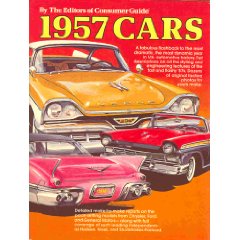 1957 Cars (with Jeff Godshall, Hal Watts). Skokie, Illinois: Publications International, 1977. Consumer Guide issues of November 1977 and August 1980. “I know you are a playboy…And you got a new Fifty-seven too!” The Everly Brothers sing along to this rundown of the fabulous ’57s from Detroit. My first project for Pubs International, the beginning of a long relationship that still goes on through their magazine Collectible Automobile.
1957 Cars (with Jeff Godshall, Hal Watts). Skokie, Illinois: Publications International, 1977. Consumer Guide issues of November 1977 and August 1980. “I know you are a playboy…And you got a new Fifty-seven too!” The Everly Brothers sing along to this rundown of the fabulous ’57s from Detroit. My first project for Pubs International, the beginning of a long relationship that still goes on through their magazine Collectible Automobile.
1976
 Chrysler & Imperial: The Postwar Years. Osceola, Wis., Motorbooks International, 1976. Here’s what happened to Walter Chrysler’s empire in the first two decades after the war, when he wasn’t around to run it. Tracks the postwar renaissance under K.T. Keller (Chrysler was number two after GM until 1952), the near-failure in 1953-54, the Virgil Exner rebirth with the “Forward Look” of 1955, the age of tailfins and land yachts, through the era of the Cordoba. Wonderful quotes from designers, stylists and executives.
Chrysler & Imperial: The Postwar Years. Osceola, Wis., Motorbooks International, 1976. Here’s what happened to Walter Chrysler’s empire in the first two decades after the war, when he wasn’t around to run it. Tracks the postwar renaissance under K.T. Keller (Chrysler was number two after GM until 1952), the near-failure in 1953-54, the Virgil Exner rebirth with the “Forward Look” of 1955, the age of tailfins and land yachts, through the era of the Cordoba. Wonderful quotes from designers, stylists and executives.
1975
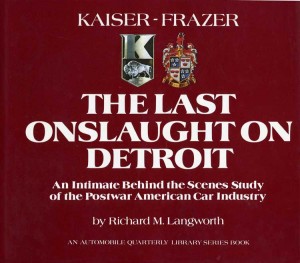 Kaiser-Frazer: Last Onslaught on Detroit. New York: Dutton, 1975; Kutztown: Bitz & Frost, 1980. “Author’s first book.” Based on dozens of interviews with former engineers, stylists and executives, packed with rare photos from prototypes to personalities, it won the Antique Automobile Club of America McKean Trophy and the Society of Automotive Historians Cugnot Award for the best automotive book of 1975. But Kaiser-Frazer was a blip in automotive history, and some said its cars were the answer to a question nobody asked. You pays your money and you takes your choice, but if you want to hear the recollections of people who made Detroit what it was in the 1950s, this book is for you. Look for copies on bookfinder.
Kaiser-Frazer: Last Onslaught on Detroit. New York: Dutton, 1975; Kutztown: Bitz & Frost, 1980. “Author’s first book.” Based on dozens of interviews with former engineers, stylists and executives, packed with rare photos from prototypes to personalities, it won the Antique Automobile Club of America McKean Trophy and the Society of Automotive Historians Cugnot Award for the best automotive book of 1975. But Kaiser-Frazer was a blip in automotive history, and some said its cars were the answer to a question nobody asked. You pays your money and you takes your choice, but if you want to hear the recollections of people who made Detroit what it was in the 1950s, this book is for you. Look for copies on bookfinder.
1972-73
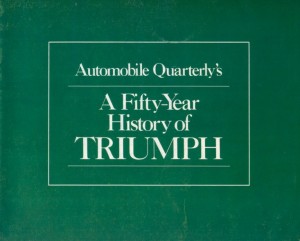 Fifty Years of Triumph. (Link is to the original appearance.) New York: Automobile Quarterly Publications, 1973. A softbound distillation of my Triumph piece in Automobile Quarterly, reprinted for distribution by British Leyland Motors to help promote the current line. There were a some historical gaffes and a few howlers. Triumph historian Graham Robson kindly corrected me, and that led to our collaboration, and a great co-authored book, Triumph Cars (above).
Fifty Years of Triumph. (Link is to the original appearance.) New York: Automobile Quarterly Publications, 1973. A softbound distillation of my Triumph piece in Automobile Quarterly, reprinted for distribution by British Leyland Motors to help promote the current line. There were a some historical gaffes and a few howlers. Triumph historian Graham Robson kindly corrected me, and that led to our collaboration, and a great co-authored book, Triumph Cars (above).
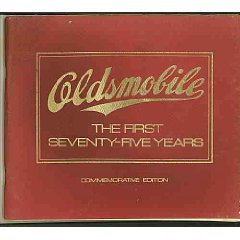 Oldsmobile: The First Seventy-five Years (with Beverly Rae Kimes). New York: Automobile Quarterly Publications, 1972. Co-authored with my old colleague (she did the pre-World War II history, I wrote the postwar). Issued for Olds dealer distribution as a paperback (illustrated) as well as a hardback with dust jacket. Fair to middlin’ photography, only 72 pages: a capsule history.
Oldsmobile: The First Seventy-five Years (with Beverly Rae Kimes). New York: Automobile Quarterly Publications, 1972. Co-authored with my old colleague (she did the pre-World War II history, I wrote the postwar). Issued for Olds dealer distribution as a paperback (illustrated) as well as a hardback with dust jacket. Fair to middlin’ photography, only 72 pages: a capsule history.
1971
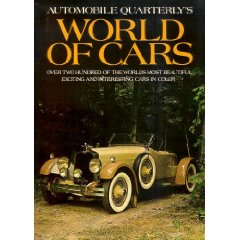 World of Cars. New York: Dutton, 1971. An interesting first assignment after I joined Automobile Quarterly in 1970. Dutton wanted a slick coffee table car book using AQ photography; art director Ted Hall did the layouts (no desktop program in those days), giving me a few breaks by allowing large format for cars I liked. My job was to write the copy to fit in the space Ted had left. The copy was the work of many authors. The finished book, printed on very heavy enamel, weighed nearly three pounds. Too bad they didn’t pay us by the ounce.
World of Cars. New York: Dutton, 1971. An interesting first assignment after I joined Automobile Quarterly in 1970. Dutton wanted a slick coffee table car book using AQ photography; art director Ted Hall did the layouts (no desktop program in those days), giving me a few breaks by allowing large format for cars I liked. My job was to write the copy to fit in the space Ted had left. The copy was the work of many authors. The finished book, printed on very heavy enamel, weighed nearly three pounds. Too bad they didn’t pay us by the ounce.

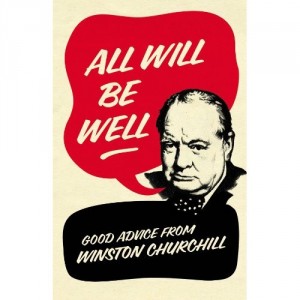
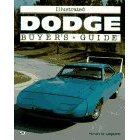







Thanks for that interesting story. I never heard of the car but when I wrote my Thunderbird book I mainly interviewed designers and engineers, so it was unlikely I’d run into it. Quite possible–anything was possible in those days. I have published your note and phone number in case any reader can help. Have you tried the International Thunderbird Club ?
I have a 1958 Tbird allegedly made for Ford for the state police of Pennsylvania. My father bought the car in 1961 and later when he needed suspension parts, nothing fit. Ford came to see what the problem was and revealed the car was built for the state police and the suspension and motor were custom. We did not get any documentation, but its performance revealed it was not stock. I recently had the engine rebuilt and the rebuilder said he had never seen a Ford engine like this one. Can you help me document this custom-built car? My phone is 330 604 6165 and I would greatly appreciate hearing from anyone who could help. The car is all original and in good condition, and I never reached top speed as I aborted at 140 mph.
Click on the links provided for most book titles. They are to Amazon USA. Amazon has other outlets worldwide. If you can’t find a title on Amazon, try bookfinder.com
Gentlemen I would like to order Vintage Car Books
would you tell me the procedure.
Regards,
Asif
Tom, thanks for the kind words. I’m resonsible for all those cars? (I blush, but not for long.) If you can put up with Winston Churchill instead of old cars, I will be making my first-ever visit to Nashville in October. See the post under “Appearances.”
Thank you Mr. Langworth for many wonderful hours reading your automotive histories. You are the reason I own a ’48 Chrysler,’54 Chrysler Windsor and ’47 Packard Clipper Super. Have read your postwar history of Hudson at least twice. I never travel without a copy of one of your books. My newest car is a 50K mile 1952 Lincoln Cosmopolitan hardtop that I take delivery of in a day or two. Have always wanted to meet you and this is the a close second getting to speak to you.Nashville is getting so hectic, not as much fun to drive a vintage car but try to when I can.
Thanks very much for the kind words, Hallgeir. Charles Nash, George Mason, George Romney and Roy Chapin built a great company with many innovations: Twin-Ignition, the great Ambassadors, the first postwar compact (Rambler), the unique Metropolitan, the Nash-Healey and more. Try Charles K. Hyde’s Storied Independent Automakers: Nash, Hudson and American Motors. https://www.amazon.com/dp/B00MMSKGUM/?tag=richmlang-20
I am a Norwegian who has studied 50,000 pages of American automotive history. Richard Langworth is the man. He has taken the story of the American cars to a new level, not only for me but the world. I want you in the future to write a story of the underdog in the American car story. Please make a great book about Nash. Thats missing in the picture I see of the American cars. But thank you for all you have done to inform us about the biggest Industry in the world. —Hallgeir
G’day Richard, I recently picked up a well worn copy of Personal luxury, the Thunderbird Story, and I was thoroughly wrapped that someone has written a book on T-birds including to the Bunkie [Knudsen] Birds of 1970-71. I purchased a 1970 Landau 2010 and whilst the car needs restoration it only set me back $5000 which is not bad considering it came from LA to Melbourne, Australia! A really great read mate, and skipping through the covers of your other works I have noticed that I four more, all really enjoyable. Thanks again, Lorne Sturdy, Emerald, Melbourne, Victoria. (Cheers, Lorne, good luck with yer Bonzer Bird. RML)
My first automobile ride was in a 1950 Studebaker Champion with the greenhouse rear window. My first long vacation trip with my parents was in a turquoise 1954 Studebaker Conestoga Wagon. The first car I ever drove was a 1965 Studebaker Lark station wagon with the sliding roof. Such memories. Since then it has been strictly Volvos and a Subaru Forester. (Nobody’s perfect, Doug! RML)